Construction Law Task-Based Assignment 2018: ADR and Time Extension
VerifiedAdded on 2020/04/15
|13
|3263
|337
Homework Assignment
AI Summary
This construction law assignment delves into the intricacies of extension of time claims within construction contracts, referencing the JCT standard form. It examines the reasons for such claims, the implications of not adhering to timelines, and the role of contract administrators in granting extensions. The assignment explores relevant case law, including Henry Boot Construction (UK) Ltd v Malmaison Hotel (Manchester) Ltd and Walter Lilly & Company Ltd v. MacKay and DMW Developments Ltd, to illustrate how delays are analyzed and how entitlements to extensions are determined. The assignment also discusses contractual remedies available to employers when completion dates are missed and the importance of considering concurrent delays. Furthermore, the assignment analyzes Alternative Dispute Resolution (ADR) methods, particularly arbitration, as a means of resolving construction disputes, outlining their advantages and disadvantages. The assignment emphasizes the importance of ADR in mitigating the negative impacts of disputes on construction projects and provides an overview of the arbitration process.

Paraphrase This Document
Need a fresh take? Get an instant paraphrase of this document with our AI Paraphraser
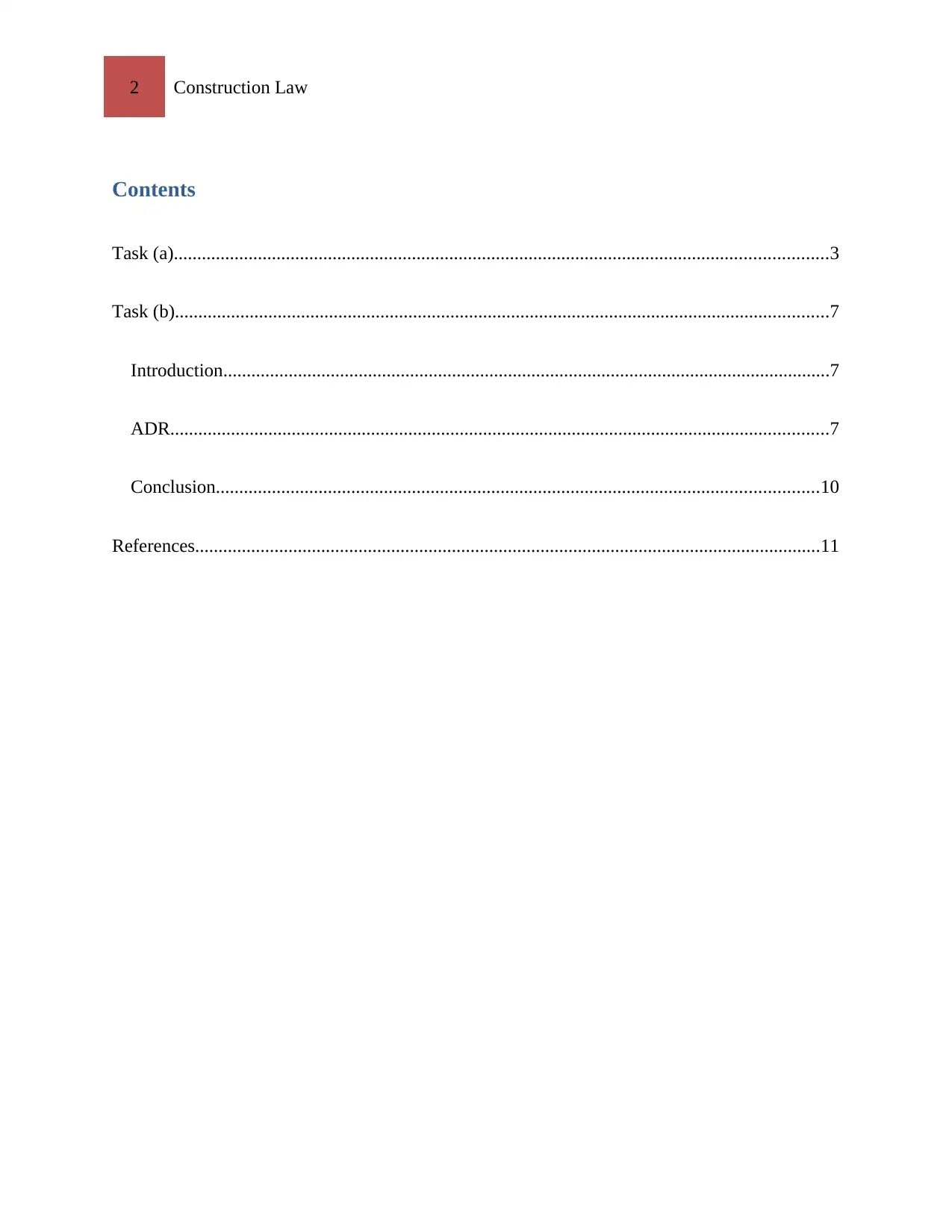
2 Construction Law
Contents
Task (a)............................................................................................................................................3
Task (b)............................................................................................................................................7
Introduction..................................................................................................................................7
ADR.............................................................................................................................................7
Conclusion.................................................................................................................................10
References......................................................................................................................................11
Contents
Task (a)............................................................................................................................................3
Task (b)............................................................................................................................................7
Introduction..................................................................................................................................7
ADR.............................................................................................................................................7
Conclusion.................................................................................................................................10
References......................................................................................................................................11
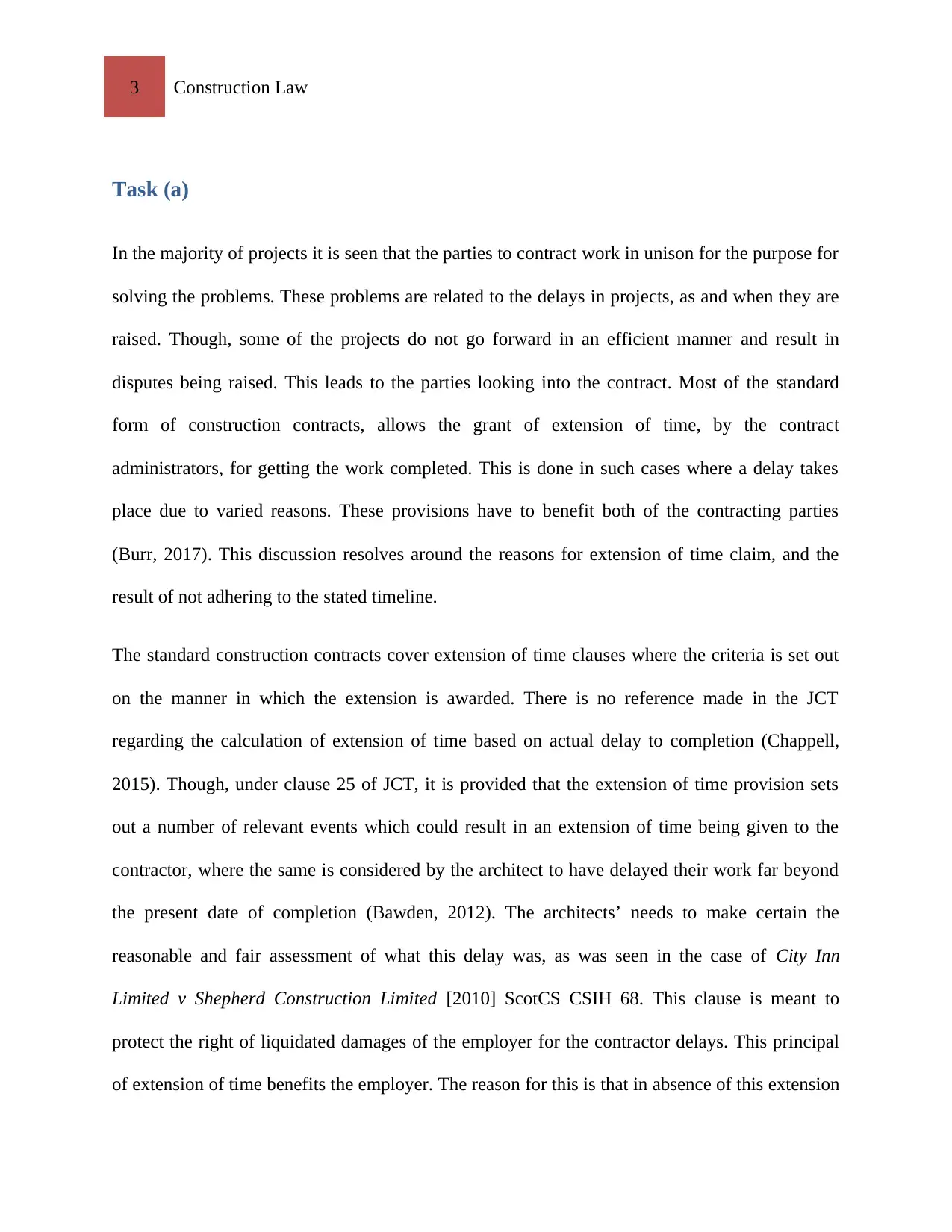
3 Construction Law
Task (a)
In the majority of projects it is seen that the parties to contract work in unison for the purpose for
solving the problems. These problems are related to the delays in projects, as and when they are
raised. Though, some of the projects do not go forward in an efficient manner and result in
disputes being raised. This leads to the parties looking into the contract. Most of the standard
form of construction contracts, allows the grant of extension of time, by the contract
administrators, for getting the work completed. This is done in such cases where a delay takes
place due to varied reasons. These provisions have to benefit both of the contracting parties
(Burr, 2017). This discussion resolves around the reasons for extension of time claim, and the
result of not adhering to the stated timeline.
The standard construction contracts cover extension of time clauses where the criteria is set out
on the manner in which the extension is awarded. There is no reference made in the JCT
regarding the calculation of extension of time based on actual delay to completion (Chappell,
2015). Though, under clause 25 of JCT, it is provided that the extension of time provision sets
out a number of relevant events which could result in an extension of time being given to the
contractor, where the same is considered by the architect to have delayed their work far beyond
the present date of completion (Bawden, 2012). The architects’ needs to make certain the
reasonable and fair assessment of what this delay was, as was seen in the case of City Inn
Limited v Shepherd Construction Limited [2010] ScotCS CSIH 68. This clause is meant to
protect the right of liquidated damages of the employer for the contractor delays. This principal
of extension of time benefits the employer. The reason for this is that in absence of this extension
Task (a)
In the majority of projects it is seen that the parties to contract work in unison for the purpose for
solving the problems. These problems are related to the delays in projects, as and when they are
raised. Though, some of the projects do not go forward in an efficient manner and result in
disputes being raised. This leads to the parties looking into the contract. Most of the standard
form of construction contracts, allows the grant of extension of time, by the contract
administrators, for getting the work completed. This is done in such cases where a delay takes
place due to varied reasons. These provisions have to benefit both of the contracting parties
(Burr, 2017). This discussion resolves around the reasons for extension of time claim, and the
result of not adhering to the stated timeline.
The standard construction contracts cover extension of time clauses where the criteria is set out
on the manner in which the extension is awarded. There is no reference made in the JCT
regarding the calculation of extension of time based on actual delay to completion (Chappell,
2015). Though, under clause 25 of JCT, it is provided that the extension of time provision sets
out a number of relevant events which could result in an extension of time being given to the
contractor, where the same is considered by the architect to have delayed their work far beyond
the present date of completion (Bawden, 2012). The architects’ needs to make certain the
reasonable and fair assessment of what this delay was, as was seen in the case of City Inn
Limited v Shepherd Construction Limited [2010] ScotCS CSIH 68. This clause is meant to
protect the right of liquidated damages of the employer for the contractor delays. This principal
of extension of time benefits the employer. The reason for this is that in absence of this extension
⊘ This is a preview!⊘
Do you want full access?
Subscribe today to unlock all pages.

Trusted by 1+ million students worldwide
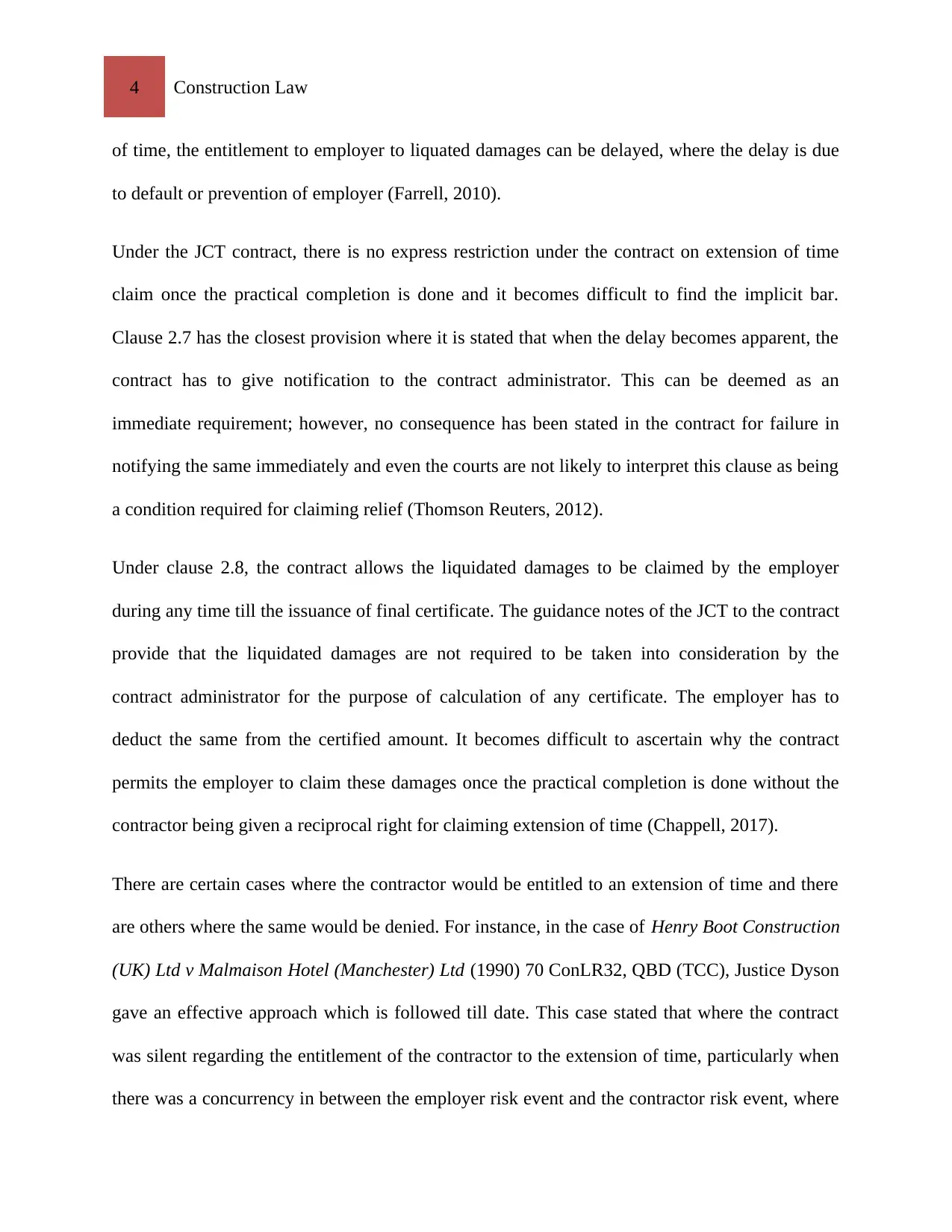
4 Construction Law
of time, the entitlement to employer to liquated damages can be delayed, where the delay is due
to default or prevention of employer (Farrell, 2010).
Under the JCT contract, there is no express restriction under the contract on extension of time
claim once the practical completion is done and it becomes difficult to find the implicit bar.
Clause 2.7 has the closest provision where it is stated that when the delay becomes apparent, the
contract has to give notification to the contract administrator. This can be deemed as an
immediate requirement; however, no consequence has been stated in the contract for failure in
notifying the same immediately and even the courts are not likely to interpret this clause as being
a condition required for claiming relief (Thomson Reuters, 2012).
Under clause 2.8, the contract allows the liquidated damages to be claimed by the employer
during any time till the issuance of final certificate. The guidance notes of the JCT to the contract
provide that the liquidated damages are not required to be taken into consideration by the
contract administrator for the purpose of calculation of any certificate. The employer has to
deduct the same from the certified amount. It becomes difficult to ascertain why the contract
permits the employer to claim these damages once the practical completion is done without the
contractor being given a reciprocal right for claiming extension of time (Chappell, 2017).
There are certain cases where the contractor would be entitled to an extension of time and there
are others where the same would be denied. For instance, in the case of Henry Boot Construction
(UK) Ltd v Malmaison Hotel (Manchester) Ltd (1990) 70 ConLR32, QBD (TCC), Justice Dyson
gave an effective approach which is followed till date. This case stated that where the contract
was silent regarding the entitlement of the contractor to the extension of time, particularly when
there was a concurrency in between the employer risk event and the contractor risk event, where
of time, the entitlement to employer to liquated damages can be delayed, where the delay is due
to default or prevention of employer (Farrell, 2010).
Under the JCT contract, there is no express restriction under the contract on extension of time
claim once the practical completion is done and it becomes difficult to find the implicit bar.
Clause 2.7 has the closest provision where it is stated that when the delay becomes apparent, the
contract has to give notification to the contract administrator. This can be deemed as an
immediate requirement; however, no consequence has been stated in the contract for failure in
notifying the same immediately and even the courts are not likely to interpret this clause as being
a condition required for claiming relief (Thomson Reuters, 2012).
Under clause 2.8, the contract allows the liquidated damages to be claimed by the employer
during any time till the issuance of final certificate. The guidance notes of the JCT to the contract
provide that the liquidated damages are not required to be taken into consideration by the
contract administrator for the purpose of calculation of any certificate. The employer has to
deduct the same from the certified amount. It becomes difficult to ascertain why the contract
permits the employer to claim these damages once the practical completion is done without the
contractor being given a reciprocal right for claiming extension of time (Chappell, 2017).
There are certain cases where the contractor would be entitled to an extension of time and there
are others where the same would be denied. For instance, in the case of Henry Boot Construction
(UK) Ltd v Malmaison Hotel (Manchester) Ltd (1990) 70 ConLR32, QBD (TCC), Justice Dyson
gave an effective approach which is followed till date. This case stated that where the contract
was silent regarding the entitlement of the contractor to the extension of time, particularly when
there was a concurrency in between the employer risk event and the contractor risk event, where
Paraphrase This Document
Need a fresh take? Get an instant paraphrase of this document with our AI Paraphraser
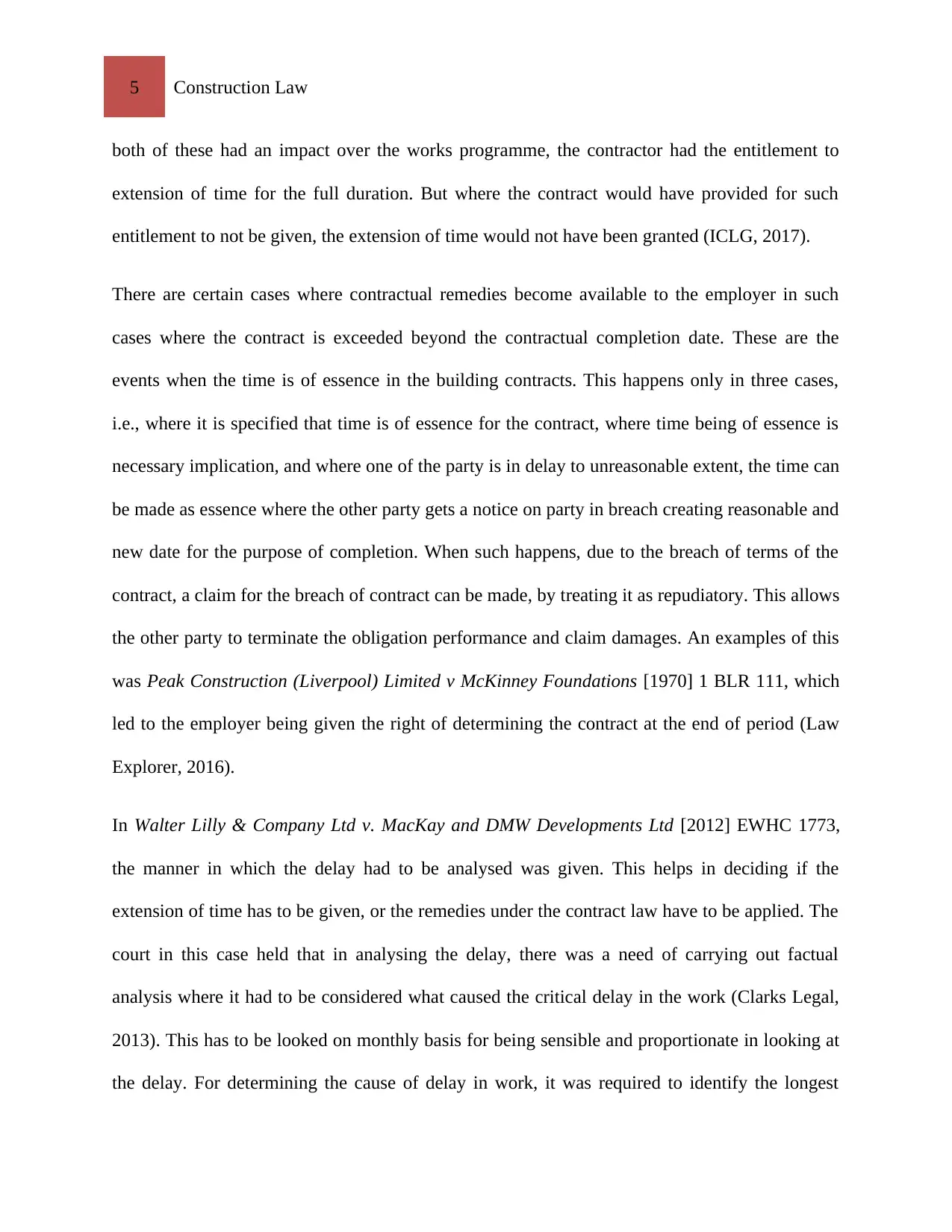
5 Construction Law
both of these had an impact over the works programme, the contractor had the entitlement to
extension of time for the full duration. But where the contract would have provided for such
entitlement to not be given, the extension of time would not have been granted (ICLG, 2017).
There are certain cases where contractual remedies become available to the employer in such
cases where the contract is exceeded beyond the contractual completion date. These are the
events when the time is of essence in the building contracts. This happens only in three cases,
i.e., where it is specified that time is of essence for the contract, where time being of essence is
necessary implication, and where one of the party is in delay to unreasonable extent, the time can
be made as essence where the other party gets a notice on party in breach creating reasonable and
new date for the purpose of completion. When such happens, due to the breach of terms of the
contract, a claim for the breach of contract can be made, by treating it as repudiatory. This allows
the other party to terminate the obligation performance and claim damages. An examples of this
was Peak Construction (Liverpool) Limited v McKinney Foundations [1970] 1 BLR 111, which
led to the employer being given the right of determining the contract at the end of period (Law
Explorer, 2016).
In Walter Lilly & Company Ltd v. MacKay and DMW Developments Ltd [2012] EWHC 1773,
the manner in which the delay had to be analysed was given. This helps in deciding if the
extension of time has to be given, or the remedies under the contract law have to be applied. The
court in this case held that in analysing the delay, there was a need of carrying out factual
analysis where it had to be considered what caused the critical delay in the work (Clarks Legal,
2013). This has to be looked on monthly basis for being sensible and proportionate in looking at
the delay. For determining the cause of delay in work, it was required to identify the longest
both of these had an impact over the works programme, the contractor had the entitlement to
extension of time for the full duration. But where the contract would have provided for such
entitlement to not be given, the extension of time would not have been granted (ICLG, 2017).
There are certain cases where contractual remedies become available to the employer in such
cases where the contract is exceeded beyond the contractual completion date. These are the
events when the time is of essence in the building contracts. This happens only in three cases,
i.e., where it is specified that time is of essence for the contract, where time being of essence is
necessary implication, and where one of the party is in delay to unreasonable extent, the time can
be made as essence where the other party gets a notice on party in breach creating reasonable and
new date for the purpose of completion. When such happens, due to the breach of terms of the
contract, a claim for the breach of contract can be made, by treating it as repudiatory. This allows
the other party to terminate the obligation performance and claim damages. An examples of this
was Peak Construction (Liverpool) Limited v McKinney Foundations [1970] 1 BLR 111, which
led to the employer being given the right of determining the contract at the end of period (Law
Explorer, 2016).
In Walter Lilly & Company Ltd v. MacKay and DMW Developments Ltd [2012] EWHC 1773,
the manner in which the delay had to be analysed was given. This helps in deciding if the
extension of time has to be given, or the remedies under the contract law have to be applied. The
court in this case held that in analysing the delay, there was a need of carrying out factual
analysis where it had to be considered what caused the critical delay in the work (Clarks Legal,
2013). This has to be looked on monthly basis for being sensible and proportionate in looking at
the delay. For determining the cause of delay in work, it was required to identify the longest
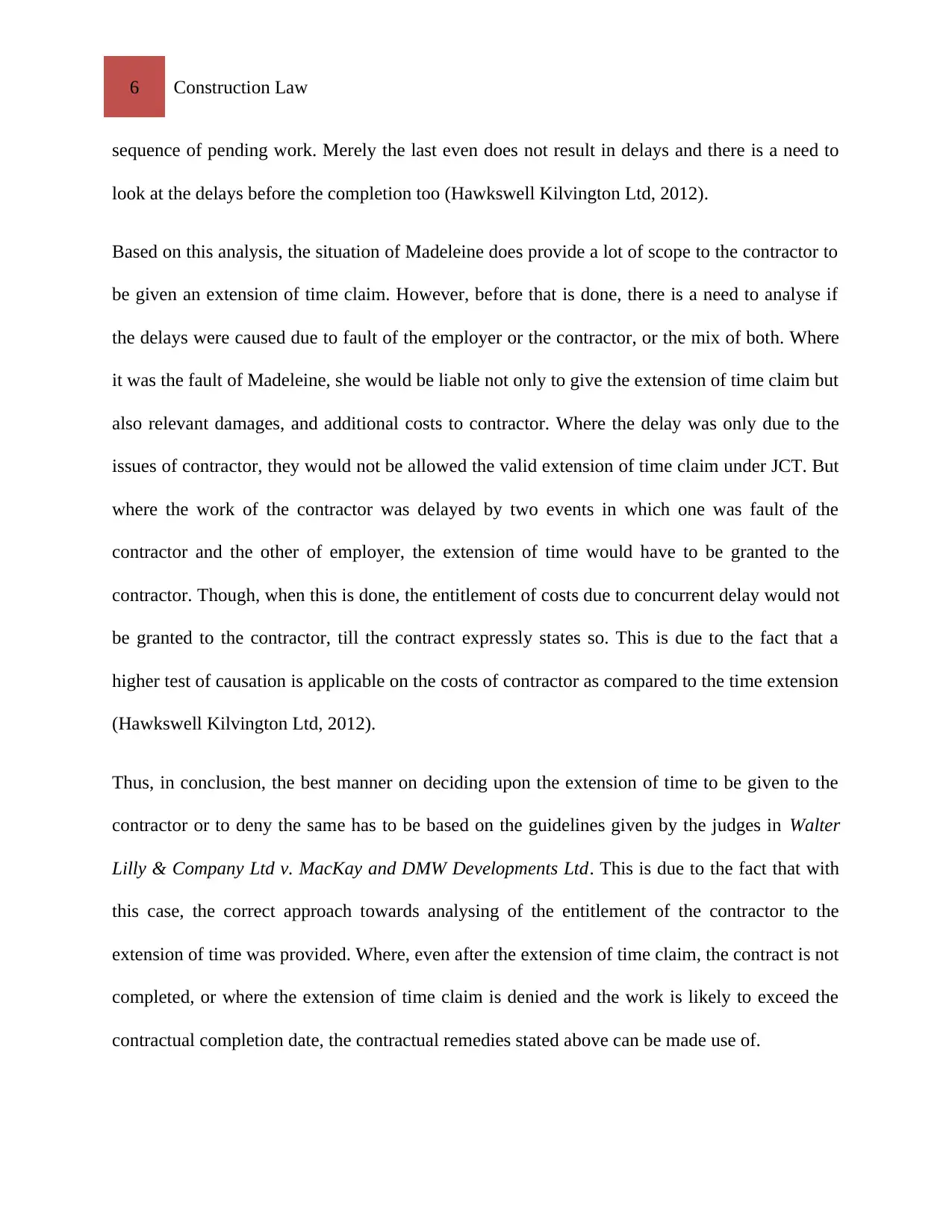
6 Construction Law
sequence of pending work. Merely the last even does not result in delays and there is a need to
look at the delays before the completion too (Hawkswell Kilvington Ltd, 2012).
Based on this analysis, the situation of Madeleine does provide a lot of scope to the contractor to
be given an extension of time claim. However, before that is done, there is a need to analyse if
the delays were caused due to fault of the employer or the contractor, or the mix of both. Where
it was the fault of Madeleine, she would be liable not only to give the extension of time claim but
also relevant damages, and additional costs to contractor. Where the delay was only due to the
issues of contractor, they would not be allowed the valid extension of time claim under JCT. But
where the work of the contractor was delayed by two events in which one was fault of the
contractor and the other of employer, the extension of time would have to be granted to the
contractor. Though, when this is done, the entitlement of costs due to concurrent delay would not
be granted to the contractor, till the contract expressly states so. This is due to the fact that a
higher test of causation is applicable on the costs of contractor as compared to the time extension
(Hawkswell Kilvington Ltd, 2012).
Thus, in conclusion, the best manner on deciding upon the extension of time to be given to the
contractor or to deny the same has to be based on the guidelines given by the judges in Walter
Lilly & Company Ltd v. MacKay and DMW Developments Ltd. This is due to the fact that with
this case, the correct approach towards analysing of the entitlement of the contractor to the
extension of time was provided. Where, even after the extension of time claim, the contract is not
completed, or where the extension of time claim is denied and the work is likely to exceed the
contractual completion date, the contractual remedies stated above can be made use of.
sequence of pending work. Merely the last even does not result in delays and there is a need to
look at the delays before the completion too (Hawkswell Kilvington Ltd, 2012).
Based on this analysis, the situation of Madeleine does provide a lot of scope to the contractor to
be given an extension of time claim. However, before that is done, there is a need to analyse if
the delays were caused due to fault of the employer or the contractor, or the mix of both. Where
it was the fault of Madeleine, she would be liable not only to give the extension of time claim but
also relevant damages, and additional costs to contractor. Where the delay was only due to the
issues of contractor, they would not be allowed the valid extension of time claim under JCT. But
where the work of the contractor was delayed by two events in which one was fault of the
contractor and the other of employer, the extension of time would have to be granted to the
contractor. Though, when this is done, the entitlement of costs due to concurrent delay would not
be granted to the contractor, till the contract expressly states so. This is due to the fact that a
higher test of causation is applicable on the costs of contractor as compared to the time extension
(Hawkswell Kilvington Ltd, 2012).
Thus, in conclusion, the best manner on deciding upon the extension of time to be given to the
contractor or to deny the same has to be based on the guidelines given by the judges in Walter
Lilly & Company Ltd v. MacKay and DMW Developments Ltd. This is due to the fact that with
this case, the correct approach towards analysing of the entitlement of the contractor to the
extension of time was provided. Where, even after the extension of time claim, the contract is not
completed, or where the extension of time claim is denied and the work is likely to exceed the
contractual completion date, the contractual remedies stated above can be made use of.
⊘ This is a preview!⊘
Do you want full access?
Subscribe today to unlock all pages.

Trusted by 1+ million students worldwide
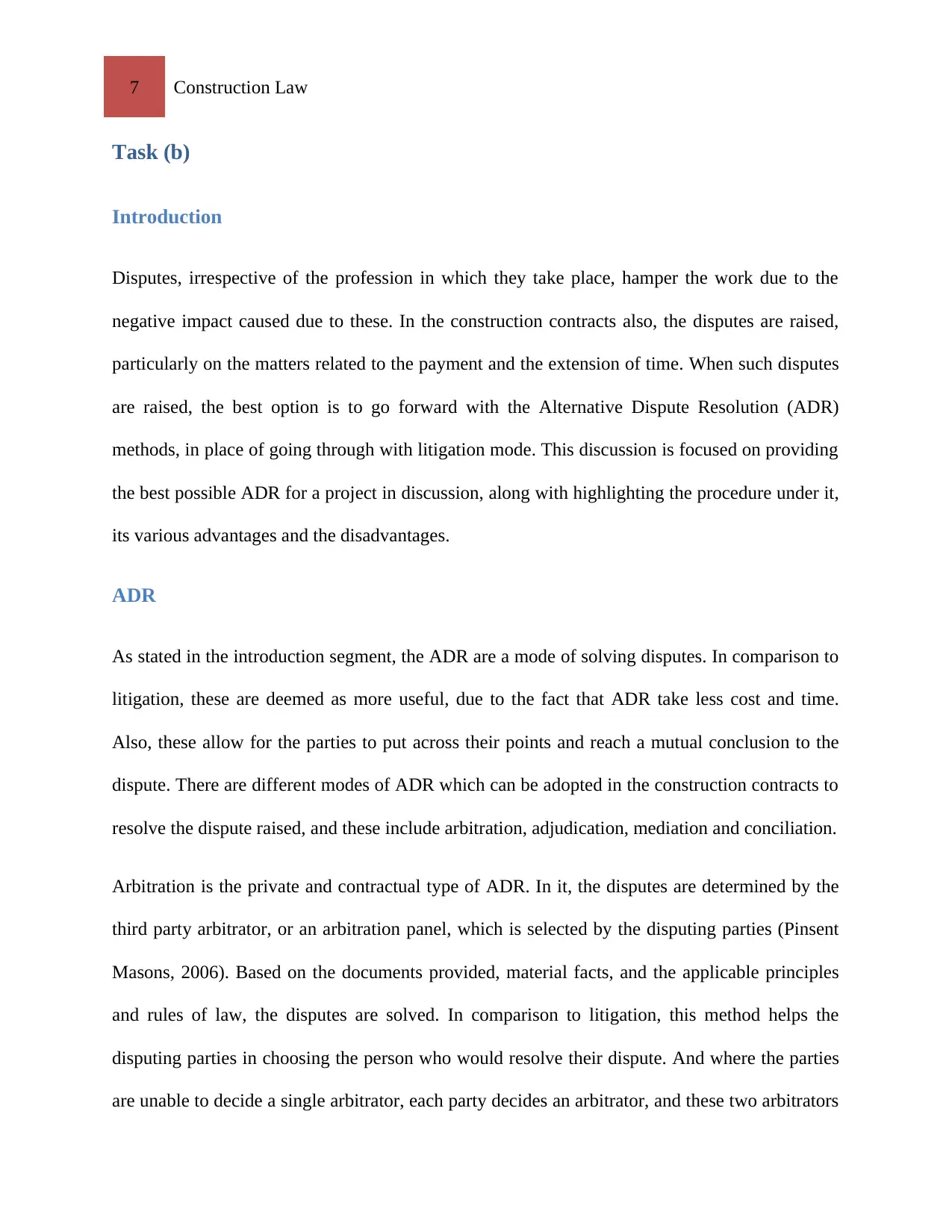
7 Construction Law
Task (b)
Introduction
Disputes, irrespective of the profession in which they take place, hamper the work due to the
negative impact caused due to these. In the construction contracts also, the disputes are raised,
particularly on the matters related to the payment and the extension of time. When such disputes
are raised, the best option is to go forward with the Alternative Dispute Resolution (ADR)
methods, in place of going through with litigation mode. This discussion is focused on providing
the best possible ADR for a project in discussion, along with highlighting the procedure under it,
its various advantages and the disadvantages.
ADR
As stated in the introduction segment, the ADR are a mode of solving disputes. In comparison to
litigation, these are deemed as more useful, due to the fact that ADR take less cost and time.
Also, these allow for the parties to put across their points and reach a mutual conclusion to the
dispute. There are different modes of ADR which can be adopted in the construction contracts to
resolve the dispute raised, and these include arbitration, adjudication, mediation and conciliation.
Arbitration is the private and contractual type of ADR. In it, the disputes are determined by the
third party arbitrator, or an arbitration panel, which is selected by the disputing parties (Pinsent
Masons, 2006). Based on the documents provided, material facts, and the applicable principles
and rules of law, the disputes are solved. In comparison to litigation, this method helps the
disputing parties in choosing the person who would resolve their dispute. And where the parties
are unable to decide a single arbitrator, each party decides an arbitrator, and these two arbitrators
Task (b)
Introduction
Disputes, irrespective of the profession in which they take place, hamper the work due to the
negative impact caused due to these. In the construction contracts also, the disputes are raised,
particularly on the matters related to the payment and the extension of time. When such disputes
are raised, the best option is to go forward with the Alternative Dispute Resolution (ADR)
methods, in place of going through with litigation mode. This discussion is focused on providing
the best possible ADR for a project in discussion, along with highlighting the procedure under it,
its various advantages and the disadvantages.
ADR
As stated in the introduction segment, the ADR are a mode of solving disputes. In comparison to
litigation, these are deemed as more useful, due to the fact that ADR take less cost and time.
Also, these allow for the parties to put across their points and reach a mutual conclusion to the
dispute. There are different modes of ADR which can be adopted in the construction contracts to
resolve the dispute raised, and these include arbitration, adjudication, mediation and conciliation.
Arbitration is the private and contractual type of ADR. In it, the disputes are determined by the
third party arbitrator, or an arbitration panel, which is selected by the disputing parties (Pinsent
Masons, 2006). Based on the documents provided, material facts, and the applicable principles
and rules of law, the disputes are solved. In comparison to litigation, this method helps the
disputing parties in choosing the person who would resolve their dispute. And where the parties
are unable to decide a single arbitrator, each party decides an arbitrator, and these two arbitrators
Paraphrase This Document
Need a fresh take? Get an instant paraphrase of this document with our AI Paraphraser
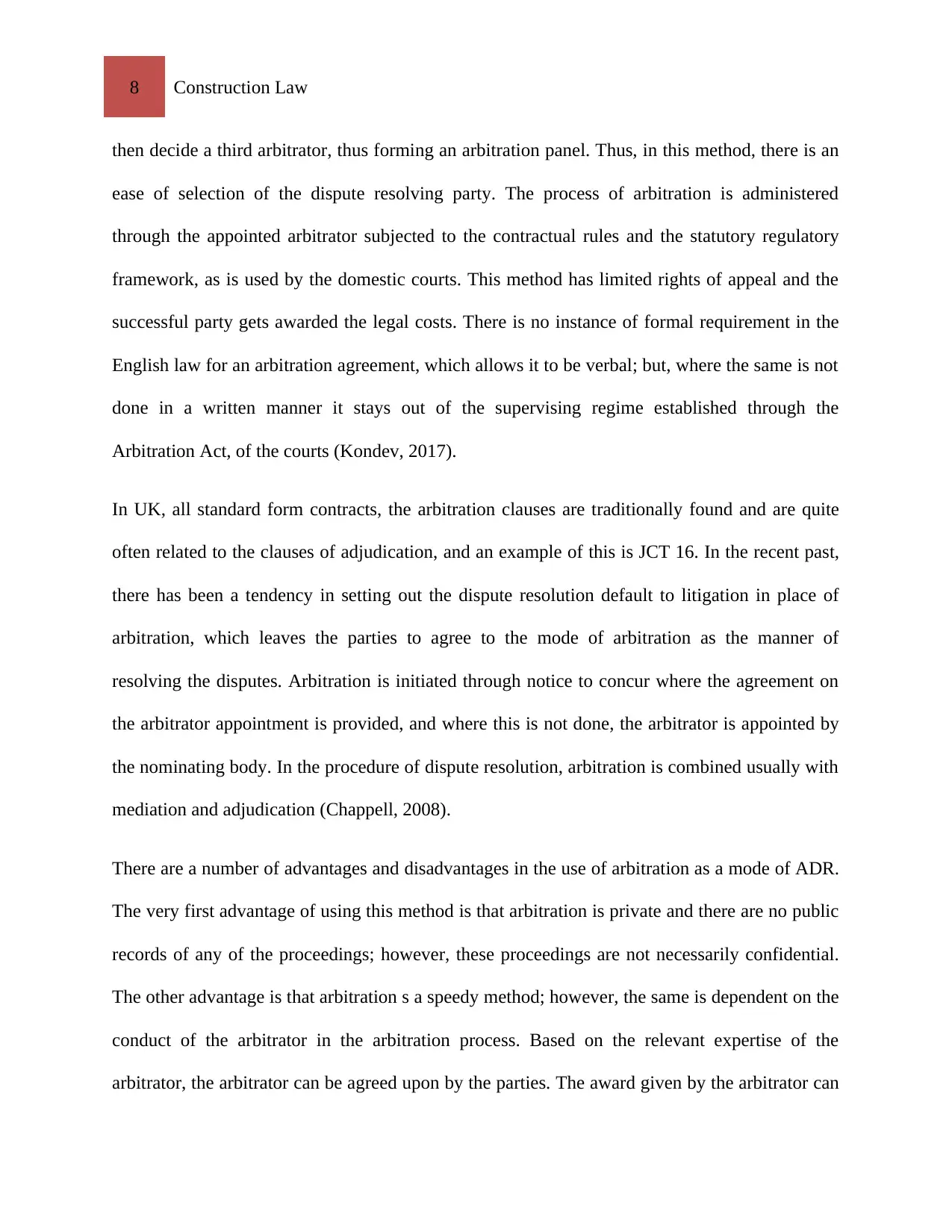
8 Construction Law
then decide a third arbitrator, thus forming an arbitration panel. Thus, in this method, there is an
ease of selection of the dispute resolving party. The process of arbitration is administered
through the appointed arbitrator subjected to the contractual rules and the statutory regulatory
framework, as is used by the domestic courts. This method has limited rights of appeal and the
successful party gets awarded the legal costs. There is no instance of formal requirement in the
English law for an arbitration agreement, which allows it to be verbal; but, where the same is not
done in a written manner it stays out of the supervising regime established through the
Arbitration Act, of the courts (Kondev, 2017).
In UK, all standard form contracts, the arbitration clauses are traditionally found and are quite
often related to the clauses of adjudication, and an example of this is JCT 16. In the recent past,
there has been a tendency in setting out the dispute resolution default to litigation in place of
arbitration, which leaves the parties to agree to the mode of arbitration as the manner of
resolving the disputes. Arbitration is initiated through notice to concur where the agreement on
the arbitrator appointment is provided, and where this is not done, the arbitrator is appointed by
the nominating body. In the procedure of dispute resolution, arbitration is combined usually with
mediation and adjudication (Chappell, 2008).
There are a number of advantages and disadvantages in the use of arbitration as a mode of ADR.
The very first advantage of using this method is that arbitration is private and there are no public
records of any of the proceedings; however, these proceedings are not necessarily confidential.
The other advantage is that arbitration s a speedy method; however, the same is dependent on the
conduct of the arbitrator in the arbitration process. Based on the relevant expertise of the
arbitrator, the arbitrator can be agreed upon by the parties. The award given by the arbitrator can
then decide a third arbitrator, thus forming an arbitration panel. Thus, in this method, there is an
ease of selection of the dispute resolving party. The process of arbitration is administered
through the appointed arbitrator subjected to the contractual rules and the statutory regulatory
framework, as is used by the domestic courts. This method has limited rights of appeal and the
successful party gets awarded the legal costs. There is no instance of formal requirement in the
English law for an arbitration agreement, which allows it to be verbal; but, where the same is not
done in a written manner it stays out of the supervising regime established through the
Arbitration Act, of the courts (Kondev, 2017).
In UK, all standard form contracts, the arbitration clauses are traditionally found and are quite
often related to the clauses of adjudication, and an example of this is JCT 16. In the recent past,
there has been a tendency in setting out the dispute resolution default to litigation in place of
arbitration, which leaves the parties to agree to the mode of arbitration as the manner of
resolving the disputes. Arbitration is initiated through notice to concur where the agreement on
the arbitrator appointment is provided, and where this is not done, the arbitrator is appointed by
the nominating body. In the procedure of dispute resolution, arbitration is combined usually with
mediation and adjudication (Chappell, 2008).
There are a number of advantages and disadvantages in the use of arbitration as a mode of ADR.
The very first advantage of using this method is that arbitration is private and there are no public
records of any of the proceedings; however, these proceedings are not necessarily confidential.
The other advantage is that arbitration s a speedy method; however, the same is dependent on the
conduct of the arbitrator in the arbitration process. Based on the relevant expertise of the
arbitrator, the arbitrator can be agreed upon by the parties. The award given by the arbitrator can
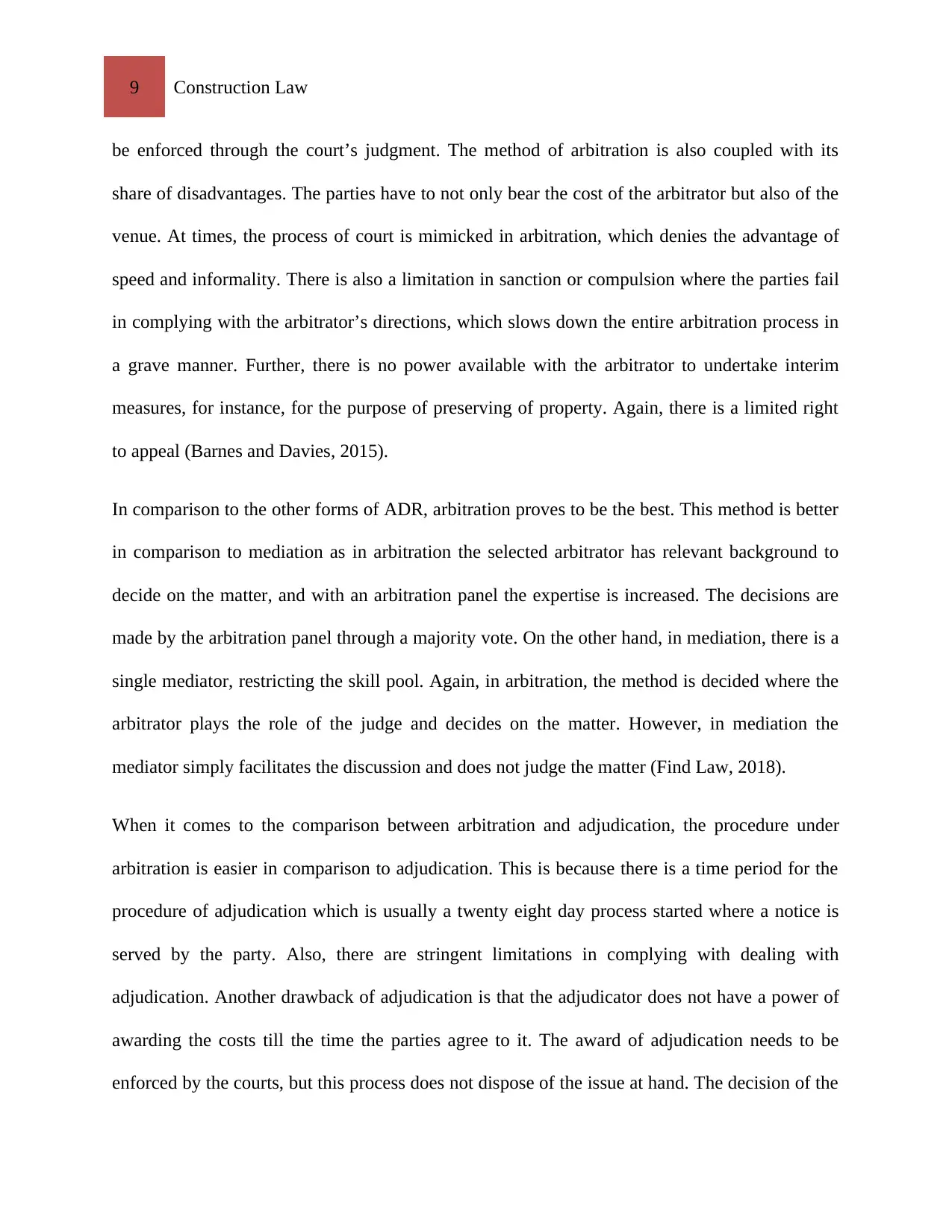
9 Construction Law
be enforced through the court’s judgment. The method of arbitration is also coupled with its
share of disadvantages. The parties have to not only bear the cost of the arbitrator but also of the
venue. At times, the process of court is mimicked in arbitration, which denies the advantage of
speed and informality. There is also a limitation in sanction or compulsion where the parties fail
in complying with the arbitrator’s directions, which slows down the entire arbitration process in
a grave manner. Further, there is no power available with the arbitrator to undertake interim
measures, for instance, for the purpose of preserving of property. Again, there is a limited right
to appeal (Barnes and Davies, 2015).
In comparison to the other forms of ADR, arbitration proves to be the best. This method is better
in comparison to mediation as in arbitration the selected arbitrator has relevant background to
decide on the matter, and with an arbitration panel the expertise is increased. The decisions are
made by the arbitration panel through a majority vote. On the other hand, in mediation, there is a
single mediator, restricting the skill pool. Again, in arbitration, the method is decided where the
arbitrator plays the role of the judge and decides on the matter. However, in mediation the
mediator simply facilitates the discussion and does not judge the matter (Find Law, 2018).
When it comes to the comparison between arbitration and adjudication, the procedure under
arbitration is easier in comparison to adjudication. This is because there is a time period for the
procedure of adjudication which is usually a twenty eight day process started where a notice is
served by the party. Also, there are stringent limitations in complying with dealing with
adjudication. Another drawback of adjudication is that the adjudicator does not have a power of
awarding the costs till the time the parties agree to it. The award of adjudication needs to be
enforced by the courts, but this process does not dispose of the issue at hand. The decision of the
be enforced through the court’s judgment. The method of arbitration is also coupled with its
share of disadvantages. The parties have to not only bear the cost of the arbitrator but also of the
venue. At times, the process of court is mimicked in arbitration, which denies the advantage of
speed and informality. There is also a limitation in sanction or compulsion where the parties fail
in complying with the arbitrator’s directions, which slows down the entire arbitration process in
a grave manner. Further, there is no power available with the arbitrator to undertake interim
measures, for instance, for the purpose of preserving of property. Again, there is a limited right
to appeal (Barnes and Davies, 2015).
In comparison to the other forms of ADR, arbitration proves to be the best. This method is better
in comparison to mediation as in arbitration the selected arbitrator has relevant background to
decide on the matter, and with an arbitration panel the expertise is increased. The decisions are
made by the arbitration panel through a majority vote. On the other hand, in mediation, there is a
single mediator, restricting the skill pool. Again, in arbitration, the method is decided where the
arbitrator plays the role of the judge and decides on the matter. However, in mediation the
mediator simply facilitates the discussion and does not judge the matter (Find Law, 2018).
When it comes to the comparison between arbitration and adjudication, the procedure under
arbitration is easier in comparison to adjudication. This is because there is a time period for the
procedure of adjudication which is usually a twenty eight day process started where a notice is
served by the party. Also, there are stringent limitations in complying with dealing with
adjudication. Another drawback of adjudication is that the adjudicator does not have a power of
awarding the costs till the time the parties agree to it. The award of adjudication needs to be
enforced by the courts, but this process does not dispose of the issue at hand. The decision of the
⊘ This is a preview!⊘
Do you want full access?
Subscribe today to unlock all pages.

Trusted by 1+ million students worldwide
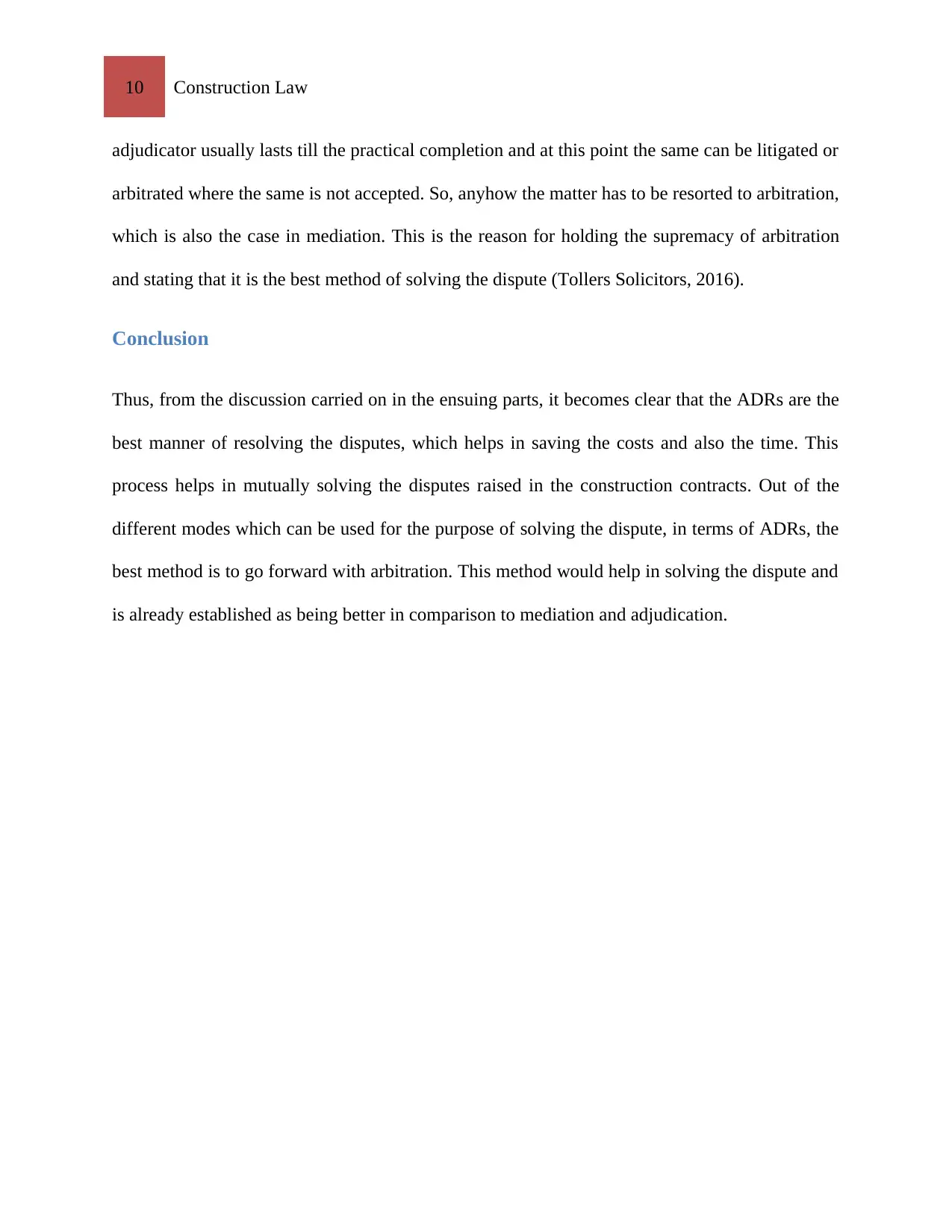
10 Construction Law
adjudicator usually lasts till the practical completion and at this point the same can be litigated or
arbitrated where the same is not accepted. So, anyhow the matter has to be resorted to arbitration,
which is also the case in mediation. This is the reason for holding the supremacy of arbitration
and stating that it is the best method of solving the dispute (Tollers Solicitors, 2016).
Conclusion
Thus, from the discussion carried on in the ensuing parts, it becomes clear that the ADRs are the
best manner of resolving the disputes, which helps in saving the costs and also the time. This
process helps in mutually solving the disputes raised in the construction contracts. Out of the
different modes which can be used for the purpose of solving the dispute, in terms of ADRs, the
best method is to go forward with arbitration. This method would help in solving the dispute and
is already established as being better in comparison to mediation and adjudication.
adjudicator usually lasts till the practical completion and at this point the same can be litigated or
arbitrated where the same is not accepted. So, anyhow the matter has to be resorted to arbitration,
which is also the case in mediation. This is the reason for holding the supremacy of arbitration
and stating that it is the best method of solving the dispute (Tollers Solicitors, 2016).
Conclusion
Thus, from the discussion carried on in the ensuing parts, it becomes clear that the ADRs are the
best manner of resolving the disputes, which helps in saving the costs and also the time. This
process helps in mutually solving the disputes raised in the construction contracts. Out of the
different modes which can be used for the purpose of solving the dispute, in terms of ADRs, the
best method is to go forward with arbitration. This method would help in solving the dispute and
is already established as being better in comparison to mediation and adjudication.
Paraphrase This Document
Need a fresh take? Get an instant paraphrase of this document with our AI Paraphraser
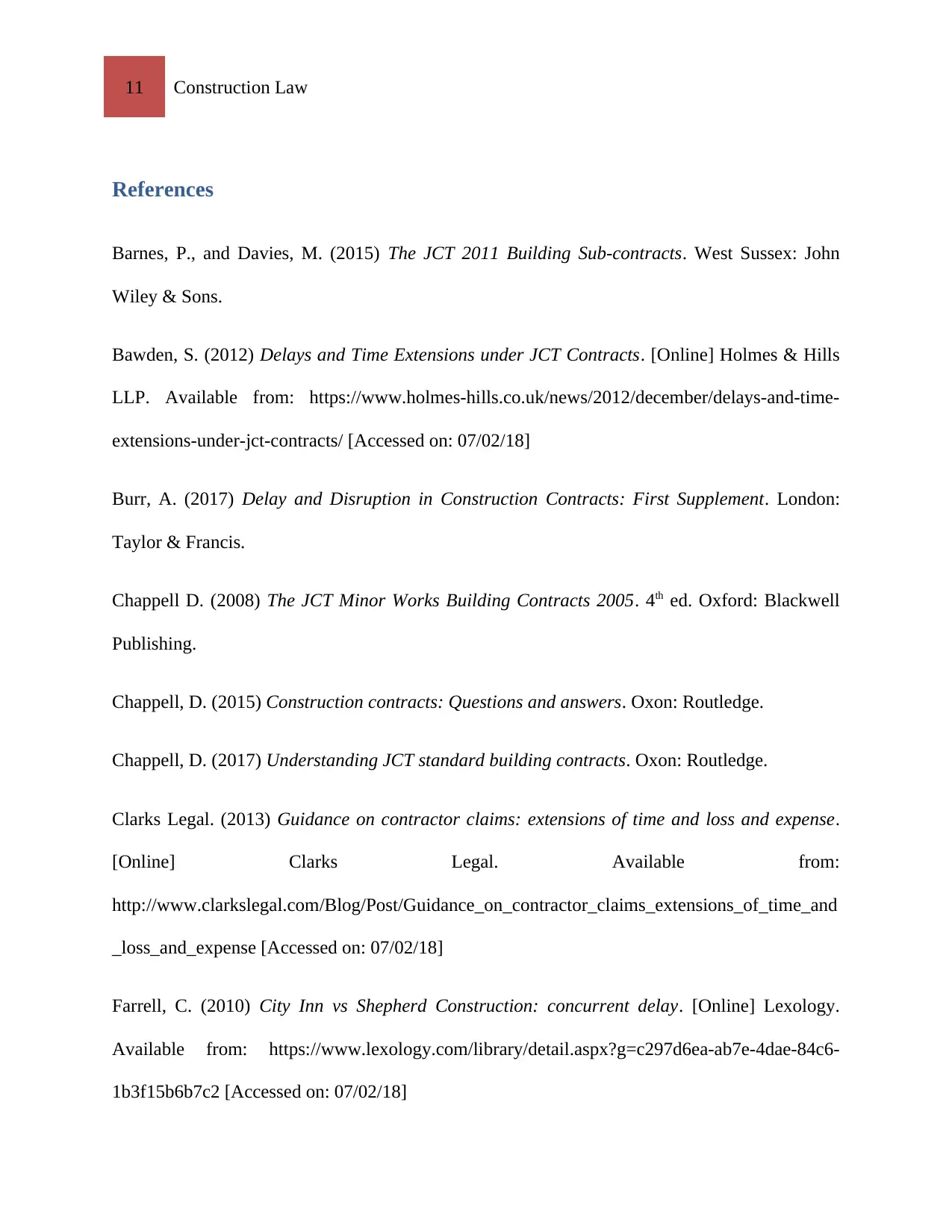
11 Construction Law
References
Barnes, P., and Davies, M. (2015) The JCT 2011 Building Sub-contracts. West Sussex: John
Wiley & Sons.
Bawden, S. (2012) Delays and Time Extensions under JCT Contracts. [Online] Holmes & Hills
LLP. Available from: https://www.holmes-hills.co.uk/news/2012/december/delays-and-time-
extensions-under-jct-contracts/ [Accessed on: 07/02/18]
Burr, A. (2017) Delay and Disruption in Construction Contracts: First Supplement. London:
Taylor & Francis.
Chappell D. (2008) The JCT Minor Works Building Contracts 2005. 4th ed. Oxford: Blackwell
Publishing.
Chappell, D. (2015) Construction contracts: Questions and answers. Oxon: Routledge.
Chappell, D. (2017) Understanding JCT standard building contracts. Oxon: Routledge.
Clarks Legal. (2013) Guidance on contractor claims: extensions of time and loss and expense.
[Online] Clarks Legal. Available from:
http://www.clarkslegal.com/Blog/Post/Guidance_on_contractor_claims_extensions_of_time_and
_loss_and_expense [Accessed on: 07/02/18]
Farrell, C. (2010) City Inn vs Shepherd Construction: concurrent delay. [Online] Lexology.
Available from: https://www.lexology.com/library/detail.aspx?g=c297d6ea-ab7e-4dae-84c6-
1b3f15b6b7c2 [Accessed on: 07/02/18]
References
Barnes, P., and Davies, M. (2015) The JCT 2011 Building Sub-contracts. West Sussex: John
Wiley & Sons.
Bawden, S. (2012) Delays and Time Extensions under JCT Contracts. [Online] Holmes & Hills
LLP. Available from: https://www.holmes-hills.co.uk/news/2012/december/delays-and-time-
extensions-under-jct-contracts/ [Accessed on: 07/02/18]
Burr, A. (2017) Delay and Disruption in Construction Contracts: First Supplement. London:
Taylor & Francis.
Chappell D. (2008) The JCT Minor Works Building Contracts 2005. 4th ed. Oxford: Blackwell
Publishing.
Chappell, D. (2015) Construction contracts: Questions and answers. Oxon: Routledge.
Chappell, D. (2017) Understanding JCT standard building contracts. Oxon: Routledge.
Clarks Legal. (2013) Guidance on contractor claims: extensions of time and loss and expense.
[Online] Clarks Legal. Available from:
http://www.clarkslegal.com/Blog/Post/Guidance_on_contractor_claims_extensions_of_time_and
_loss_and_expense [Accessed on: 07/02/18]
Farrell, C. (2010) City Inn vs Shepherd Construction: concurrent delay. [Online] Lexology.
Available from: https://www.lexology.com/library/detail.aspx?g=c297d6ea-ab7e-4dae-84c6-
1b3f15b6b7c2 [Accessed on: 07/02/18]
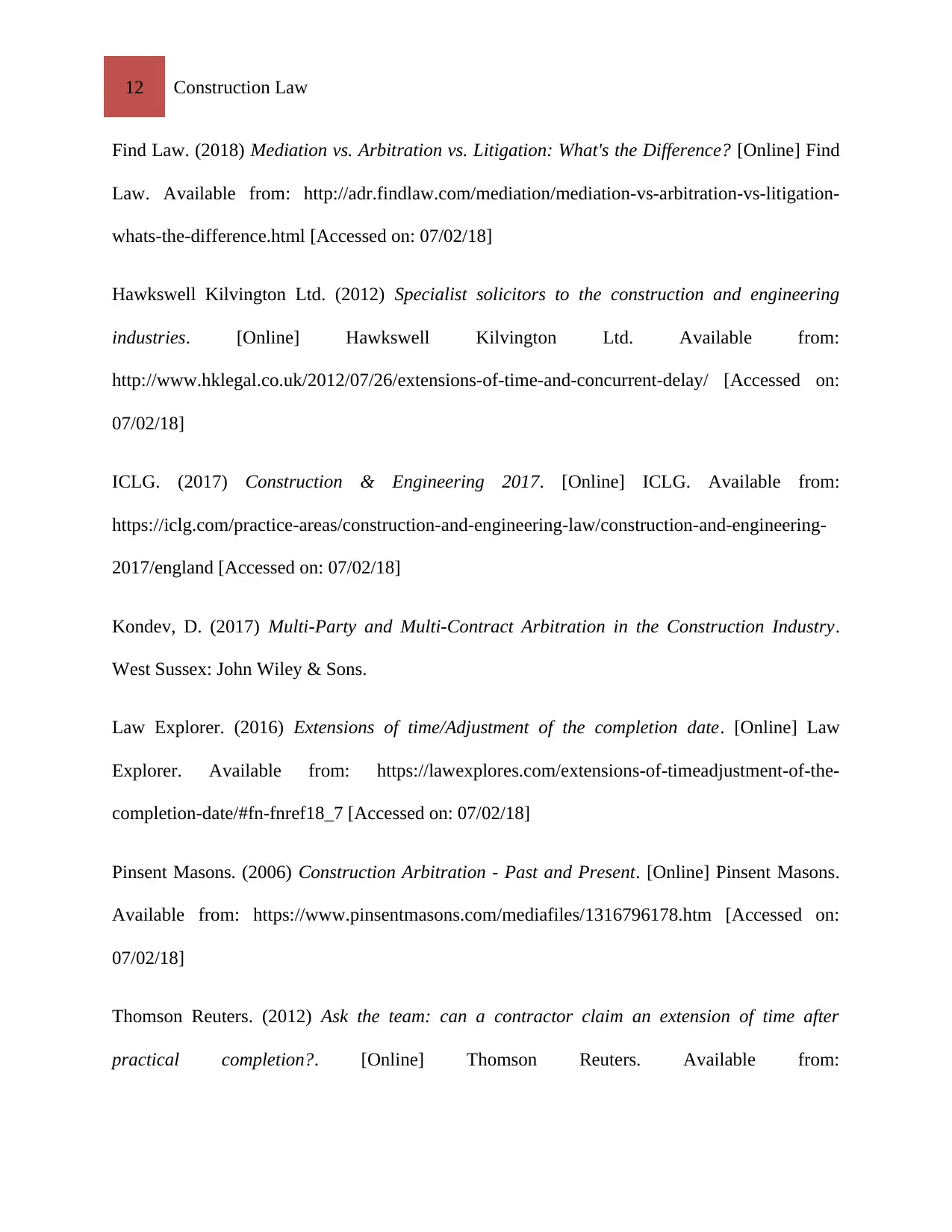
12 Construction Law
Find Law. (2018) Mediation vs. Arbitration vs. Litigation: What's the Difference? [Online] Find
Law. Available from: http://adr.findlaw.com/mediation/mediation-vs-arbitration-vs-litigation-
whats-the-difference.html [Accessed on: 07/02/18]
Hawkswell Kilvington Ltd. (2012) Specialist solicitors to the construction and engineering
industries. [Online] Hawkswell Kilvington Ltd. Available from:
http://www.hklegal.co.uk/2012/07/26/extensions-of-time-and-concurrent-delay/ [Accessed on:
07/02/18]
ICLG. (2017) Construction & Engineering 2017. [Online] ICLG. Available from:
https://iclg.com/practice-areas/construction-and-engineering-law/construction-and-engineering-
2017/england [Accessed on: 07/02/18]
Kondev, D. (2017) Multi-Party and Multi-Contract Arbitration in the Construction Industry.
West Sussex: John Wiley & Sons.
Law Explorer. (2016) Extensions of time/Adjustment of the completion date. [Online] Law
Explorer. Available from: https://lawexplores.com/extensions-of-timeadjustment-of-the-
completion-date/#fn-fnref18_7 [Accessed on: 07/02/18]
Pinsent Masons. (2006) Construction Arbitration - Past and Present. [Online] Pinsent Masons.
Available from: https://www.pinsentmasons.com/mediafiles/1316796178.htm [Accessed on:
07/02/18]
Thomson Reuters. (2012) Ask the team: can a contractor claim an extension of time after
practical completion?. [Online] Thomson Reuters. Available from:
Find Law. (2018) Mediation vs. Arbitration vs. Litigation: What's the Difference? [Online] Find
Law. Available from: http://adr.findlaw.com/mediation/mediation-vs-arbitration-vs-litigation-
whats-the-difference.html [Accessed on: 07/02/18]
Hawkswell Kilvington Ltd. (2012) Specialist solicitors to the construction and engineering
industries. [Online] Hawkswell Kilvington Ltd. Available from:
http://www.hklegal.co.uk/2012/07/26/extensions-of-time-and-concurrent-delay/ [Accessed on:
07/02/18]
ICLG. (2017) Construction & Engineering 2017. [Online] ICLG. Available from:
https://iclg.com/practice-areas/construction-and-engineering-law/construction-and-engineering-
2017/england [Accessed on: 07/02/18]
Kondev, D. (2017) Multi-Party and Multi-Contract Arbitration in the Construction Industry.
West Sussex: John Wiley & Sons.
Law Explorer. (2016) Extensions of time/Adjustment of the completion date. [Online] Law
Explorer. Available from: https://lawexplores.com/extensions-of-timeadjustment-of-the-
completion-date/#fn-fnref18_7 [Accessed on: 07/02/18]
Pinsent Masons. (2006) Construction Arbitration - Past and Present. [Online] Pinsent Masons.
Available from: https://www.pinsentmasons.com/mediafiles/1316796178.htm [Accessed on:
07/02/18]
Thomson Reuters. (2012) Ask the team: can a contractor claim an extension of time after
practical completion?. [Online] Thomson Reuters. Available from:
⊘ This is a preview!⊘
Do you want full access?
Subscribe today to unlock all pages.

Trusted by 1+ million students worldwide
1 out of 13
Related Documents
Your All-in-One AI-Powered Toolkit for Academic Success.
+13062052269
info@desklib.com
Available 24*7 on WhatsApp / Email
![[object Object]](/_next/static/media/star-bottom.7253800d.svg)
Unlock your academic potential
Copyright © 2020–2025 A2Z Services. All Rights Reserved. Developed and managed by ZUCOL.





